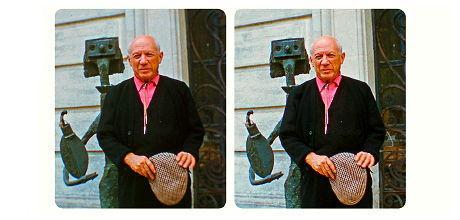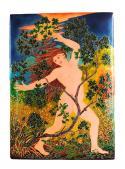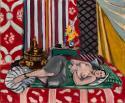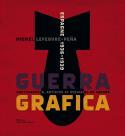Art Of The Day Weekly
#334 - from 20 February 2014 to 26 February 2014

Robert Mouzillat, Picasso on the steps of La Californie, with Woman with Orange, (1943) © Elizabeth Mouzillat Jowett (exhibition at Holburne Museum, Bath.
IN THE AIR
Picasso in 3-D
BATH – We know all about Picasso, and the photographs that immortalised him, from Capa to Doisneau, from Brassaï to André Villers. Yet, following a strange series of circumstances, a set no one has seen before pops up in an unexpected location. These shots were taken over a brief two-day period, at Easter time in 1957. On that Saturday, at villa La Californie, in Cannes, there was of course the great artist, as well as Jacqueline Roque (his last companion), John Richardson (one of his biographers) and photographer David Douglas Duncan. On the next day they all went to Arles to the bull fight. And to join old friends: Oscar Domínguez, Jean Cocteau and Luis Miguel Dominguín. The author of the photographs that set this full weekend for posterity, Robert Mouzillat (1913-2010), was an inventor. His process of volume photos had tickled Picasso’s curiosity, and the artist had given him ‘carte blanche’. Three years after the death of Mouzillat his daughter, who lived in England, finally opened his archives. They open the door to Picasso’s intimacy, in particular to the living-room and its extraordinary cacophony of furniture and sculptures. The exhibition only gives us a glimpse, but the discovery could be followed with the booklet and its special glasses, perfected by Brian May, the president of the London Stereoscopic Company and former drummer of the group Queen. All roads lead to Picasso…
• Stereoscopic Photographs of Pablo Picasso at the Holburne Museum (Pulteney Road), from 22 February to 1st June 2014.
EXHIBITIONS

Gustave Doré, Souvenir of Loch Lamond, 1875. Oil on canvas, 131 x 196 cm. New York, private collection © French & Company, New York.
Saving Gustave Doré
PARIS - An excellent illustrator of the Bible, of Dante and Rabelais! The perfect interpreter of Cervantès’ Don Quijote. What more could we say about Gustave Doré (1832-1883)? Could we add that he produced the images for an interesting Voyage in Spain written by baron Davillier? That he was known for his prints? We could easily bet that we could hardly say more since the reputation he enjoyed during the XIXth century declined and was not more than that of an honest practitioner. Actually, Gustave Doré was a sort of giant who excelled in a number of fields which today are forgotten. With his drawings he denounced the social injustices of his time, was a fascinating painter of landscapes and made huge biblical compositions that made him a star in London. Up to the turn of the XXth century, there was a gallery completely dedicated to his work, the Doré Gallery, that over two decades attracted an average of 100 000 visitors a year. This exhibition in Paris brings together all the artist’s aspects, over two floors far from one another, which complicates the visit just a little. But it has the clear ambition of pulling the artist out of the purgatory of drawers of family oriented books …
Gustave Doré, l’imaginaire au pouvoir at the musée d’Orsay from 18 February to 11 May 2014.
Baron Vitta, a forgotten aesthete
ÉVIAN – He was a particularly ill-known patron of the arts, even though he defended Rodin and Chéret. The Palais Lumière pays a tribute to a great collector, the discreet baron Vitta (1860-1942).
Illustration: Félix Bracquemond, La Fuite, 1910, translucent gold-cloisonne enamels on a copper plate, 32.5 x 23.5 cm © Galerie Michel Giraud.
From 15 February to 1st June2014
Matisse and the human figure
FERRARA –Together with Picasso he is the other great emblematic figure of the XXth century. Matisse, la figura, at the Palazzo dei Diamanti, examines his relation to the human figure, in an explosion of colours. From the Selfportrait in 1900 to the Acrobats in 1952, the paintings are on loan from around the world, from the Centre Pompidou to the Tate, from Copenhagen and Philadelphia to La Chaux-de-Fonds.
Illustration: Henri Matisse, Odalisque au pantalon gris, 1926-27, oil on canvas, 54 x 65 cm, Paris, Musée de l’Orangerie. © Succession H. Matisse, by SIAE 2013.
From 22 February to 15 June 2014.
Picasso and his models
BREMEN – The women he loved -Fernande, Marie-Thérèse, Françoise, Jacqueline, etc.- were not Picasso’s only sources of inspiration. His relation to the feminine model is the theme of Sylvette, Sylvette, Sylvette, an exhibition the Kunsthalle focused on the specific case of Sylvette David. From 22 February to 22 June 2014.
Faces of the XXth century
MARSEILLE – At the Vieille-Charité, the exhibition Visages offers a panorama of the face in art in the xxth century –the time of big upheavals-, through some 150 works. Picasso, Magritte and Warhol are up in front, next to Hopper, Bacon and Basquiat. From 21 February to 22 June 2104.
The great Futurist assembly
NEW YORK – We well remember a unique event at the Palazzo Grassi in Venice in 1986. The MoMA picks up where that one ended and offers an Italian Futurism, which intends to show it all regarding the movement launched by Marinetti in the period between the two wars. From 21 February to 1st September 2014.
ARTIST OF THE WEEK

Lida Abdul, Still of War Games (What I Saw), 2006. Film 16mm on DVD, 6’00’’. Courtesy the artist and gallery Giorgio Persano.
Lida Abdul, the endless war
War has always challenged artists. Among the most recent works on this subject we can mention, in no order whatsoever, the topographies of Sophie Ristelhueber, the photographic reconstitutions of Eric Baudelaire or the videos of Haroun Farocki, a true plunge into the deliriums of virtual representation. Lida Abdul is a member of this fraternity in a more ‘carnal’ manner. Indeed, she is from Afghanistan, a country that has been scared by conflicts for decades and her whole life –she was born in 1973 – has been marked by it. What we saw about awakening (2006) is one of her best-known works: men in black try to demolish a respectable stone monument with ropes, as if seeking to erase the past and history. She was first a refugee in Germany and in India, and now lives in California. But she comes back to her native country regularly and with all the supports available (photo, video, installations) tries to draw from it the traces of a constantly renewed violence.
• Lida Abdul is presented at the Fondation Calouste Gulbenkian until 30 March 2014.
OPENINGS OF THE WEEK

BOOKS
¡No pasarán!
The war in Spain was in a way a “pioneer” from many points of view, for example in the use of planes, of which the shelling of Guernica is the most tragic example. It was also the first war that was so covered by the media– the wires from Hemingway and Kessel, the photos by Robert Capa, Gerda Taro or Chim prove it. Through posters and typography, the war continues through other forms. Based on the author’s rich collection, the work shows creativity was brilliantly put to serve a cause with the drawings and prints by Frans Masereel, George Grosz and Géo Ham, the photomontages by John Heartfield or the posters by Miró. We discover a few curiosities such as these trains painted with giant manifestoes or the anti-Franco slogans in US chewing-gums! The fact the Republicans clearly won the propaganda war did not affect the end of the conflict in any way. As Albert Camus wrote: “It was in Spain that my generation learned one can be right and yet be beaten (…)”
• Guerra grafica, Espagne 1936-1939, by Michel Lefebvre-Peña, Editions de la Martinière, 2013, 320 p., €69.



